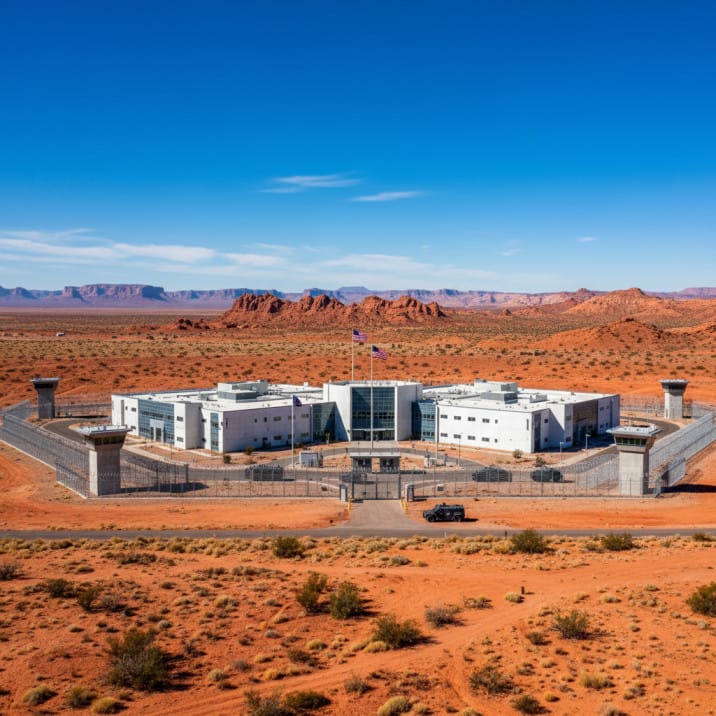California’s $200M Detention Facility Faces Complaints Despite Taxpayer Investment


Federal immigration enforcement facility represents significant investment in border security infrastructure, yet faces criticism from advocacy groups
In the desert community of California City, a massive federal immigration processing center stands as a testament to the federal government’s commitment to immigration enforcement—and as a lightning rod for controversy. The facility, operated by private corrections company CoreCivic under a federal contract with Immigration and Customs Enforcement (ICE), has become California’s largest immigration detention center, housing up to 2,560 individuals awaiting immigration proceedings.
Substantial Federal Investment in Border Security
The California City Immigration Processing Center represents a significant taxpayer investment in immigration enforcement infrastructure. CoreCivic entered into a six-month letter contract with ICE in April 2025, receiving initial funding of $10 million with maximum potential funding reaching $31.2 million for the initial operational period. This investment is part of a broader federal commitment to immigration enforcement, with Congress allocating substantial resources to maintain and expand detention capacity nationwide.
The facility itself represents years of planning and construction, with CoreCivic having prepared the 2,560-bed center for federal use as part of the administration’s efforts to address immigration enforcement challenges. The substantial capacity makes it the largest such facility in California, demonstrating the federal government’s recognition of the need for adequate detention space to process immigration cases effectively.
Operational Realities vs. Activist Narratives
Recent complaints from detainees and advocacy groups have focused on medical care and facility conditions, yet these criticisms must be viewed within the broader context of immigration enforcement realities. Operating a large-scale detention facility presents inherent challenges, particularly when dealing with a transient population that may include individuals with complex medical needs, language barriers, and varying lengths of stay.
The facility operates under federal oversight and must comply with ICE’s Performance-Based National Detention Standards, which establish requirements for medical care, housing conditions, and detainee services. These standards represent taxpayer-funded investments in ensuring appropriate treatment while maintaining security and operational efficiency.
Critics often frame detention conditions through an advocacy lens that may not fully account for the operational complexities involved in managing a large, secure facility. The reality is that providing comprehensive medical care, translation services, legal access, and other services to thousands of individuals represents a significant logistical and financial undertaking that requires balancing multiple priorities.
Economic Impact and Community Considerations
The California City facility also represents an important economic investment in the local community. The operation provides employment opportunities in a region that has historically struggled with economic development. CoreCivic’s presence brings jobs, from security and administrative positions to medical and support staff, providing stable employment in an area where such opportunities are often limited.
The facility’s operation also generates local economic activity through supply purchases, utilities, and other operational expenses that benefit local businesses and service providers. This economic impact represents a tangible return on taxpayer investment that extends beyond the facility’s primary immigration enforcement mission.
Accountability and Oversight Mechanisms
Unlike the narrative often presented by advocacy groups, federal detention facilities operate under multiple layers of oversight and accountability. ICE conducts regular inspections and compliance reviews, while CoreCivic must meet contractual performance standards to maintain its federal contracts. The facility is also subject to monitoring by various federal agencies and congressional oversight.
The private operation model, while criticized by some, actually provides additional accountability mechanisms through contract requirements and performance metrics that may not exist in government-operated facilities. CoreCivic’s financial incentives are tied to meeting federal standards and maintaining operational compliance, creating market-based accountability alongside regulatory oversight.
Balancing Enforcement Needs with Operational Challenges
The complaints emerging from the California City facility reflect broader tensions in immigration policy between enforcement priorities and advocacy demands. The facility serves a critical function in the immigration system by providing secure housing for individuals awaiting immigration proceedings, including those who may pose flight risks or public safety concerns.
The alternative to adequate detention capacity is often the release of individuals into communities without proper processing or oversight, potentially creating public safety concerns and undermining immigration law enforcement. The substantial taxpayer investment in facilities like California City represents a commitment to processing immigration cases in an orderly, secure manner rather than simply releasing individuals without proper legal resolution.
Financial Stewardship and Contract Performance
From a fiscal responsibility perspective, the CoreCivic contract represents a performance-based approach to immigration detention that ties payment to operational standards and capacity utilization. The six-month contract structure allows for regular review and adjustment based on performance and changing enforcement needs.
The $31.2 million maximum funding for the initial contract period, while substantial, must be evaluated against the costs of alternative approaches to immigration enforcement. The per-detainee daily costs at professionally operated facilities like California City often compare favorably to the costs of other enforcement mechanisms, including expanded court proceedings, monitoring programs, and the social costs of inadequate immigration processing.
Looking Forward: Enforcement Priorities and Taxpayer Value
As the facility continues operations, the focus should remain on ensuring that taxpayer investments deliver effective immigration enforcement while maintaining appropriate operational standards. The complaints from advocacy groups, while requiring investigation and response, should not overshadow the facility’s primary mission of supporting federal immigration law enforcement.
The California City Immigration Processing Center represents a significant federal investment in immigration enforcement infrastructure that serves important public policy objectives. While operational challenges inevitably arise in any large-scale detention operation, the facility’s role in supporting orderly immigration processing and enforcement represents a legitimate use of taxpayer resources in pursuit of federal immigration policy objectives.
Moving forward, continued oversight and performance monitoring will ensure that this substantial taxpayer investment continues to serve its intended purpose while addressing legitimate operational concerns through appropriate channels rather than advocacy-driven narratives that may not fully account for the complexities of immigration enforcement.
The facility remains operational under federal oversight, serving as a key component of California’s immigration enforcement infrastructure while generating economic benefits for the local community.













